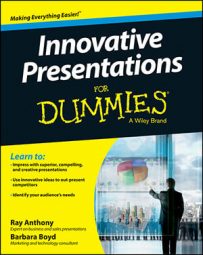There are several ways to encourage audience interactions in your innovative presentation. Trainers use learning exercises, case studies, role playing, and questioning to get people to use the information they have acquired in real-world simulation in the classroom — to just do it.
For example, Ray Anthony who sold computers for an international company, would ask potential buyers to bring their real accounting data with them to a demonstration of his company’s minicomputers (at the time, actually accounting machines the size of a desk). With a prospect sitting down beside him, Ray would lead the person through the process of inputting the data to do accounts payable, accounts receivable, and general ledger postings.
The potential customer would then use the keyboard to type in the data and see for herself just how fast, accurate, easy, and beneficial it would be for her accounting operation. It was not Ray telling or doing it, but the person following the Law of Exercise.
The exercise part of this law combines sight, touch, and even sound (in this case the computer’s printer gave an impressively quick printout) to present a real situation that convinces the audience of the point you make. By employing these types of product demonstrations using the Law of Exercise and Engagement, prospects became buying customers.
It’s becoming more common, especially in large groups, to use a tablet or iPad to enable those in the audience to express their opinions, ideas, or questions. In large events, for example, hundreds of people in the audience can tweet comments for you to display on the big screen for all to see in real time.
Whether you’re a fan or not, social media taps into a desire to share and encourages people to express thoughts and feelings toward an interesting or concerning topic. For many people, liking, commenting, or sharing have become second nature. You can take advantage of the social mentality in your presentation. You can respond as you wish to the comments people are making for as long as it’s productive or entertaining.
Today’s interactive technology allows you to create virtual situations where the audience inputs data or manipulates information or images, along with you, to reach the conclusions you want. Augmented reality apps show the viewer the solutions to the problem or situation at hand.
By providing tablets or laptops that have a presentation or collaboration app pre-loaded (or inviting your attendees to download the app to their own devices before beginning your presentation), your traditional talking-head presentation becomes one involving the Law of Exercise.
Attendees actively participate and can see for themselves the outcomes you pose and forecast as well as comments and ideas from others in the group. Search for “collaboration” in the App Store and you discover literally hundreds of apps designed to facilitate interactive brainstorming.
Check out BaiBoard, a free Mac and iOS app (and a forthcoming Android version) that lets small workgroups collaborate on a shared whiteboard and PDF document annotation, and iBrainstorm, a multi-device collaboration tool that’s also free.
We predict that in the near future, most meetings and presentations will effectively take advantage of the Law of Engagement and Exercise where involvement is much more two-sided (involving a back-and-forth between audience and presenter) as opposed to presenter-directed, sequentially ordered talks.

